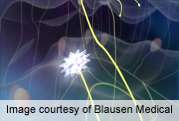(HealthDay) -- Fluorine-18-fluorodeoxyglucose (F-18-FDG) positron emission tomography (PET) is significantly more sensitive and equally specific compared with traditional computed tomography (CT) imaging for evaluation of the regional lymph node basin in patients with Merkel cell carcinoma (MCC), according to research published online May 2 in the Journal of the American Academy of Dermatology.
Michael B. Colgan, M.D., of the Mayo Clinic in Rochester, Minn., and colleagues conducted a retrospective chart review involving 240 patients with primary MCC to determine the value of various imaging modalities in staging and initial work-up of patients with MCC. Of the total, 99 patients had diagnostic imaging at initial presentation, with biopsy-proven cutaneous MCC and histopathologic nodal evaluation within four weeks of the initial scan.
The researchers compared three diagnostic imaging modes: CT (69 patients), F-18-FDG PET (33 patients), and magnetic resonance imaging (MRI) (10 patients). Compared with CT, F-18-FDG PET imaging had higher sensitivity (83 versus 47 percent), similar specificity (95 versus 97 percent) and positive-predictive value (91 versus 94 percent), and higher negative-predictive value (91 versus 68 percent) in detecting nodal basin involvement. The sensitivity, specificity, positive predictive value, and negative predictive value for detecting nodal basin involvement with MRI was 0, 86, 0, and 67 percent, respectively.
"This study was the largest to date of various imaging methods in the evaluation of regional lymph node basins in MCC with the gold standard histopathologic confirmation. Our data support the use of F-18-FDG PET over standard CT and MRI alone when imaging the regional lymph nodal basin," the authors write.
More information:
Abstract
Full Text (subscription or payment may be required)
Copyright © 2012 HealthDay. All rights reserved.



















